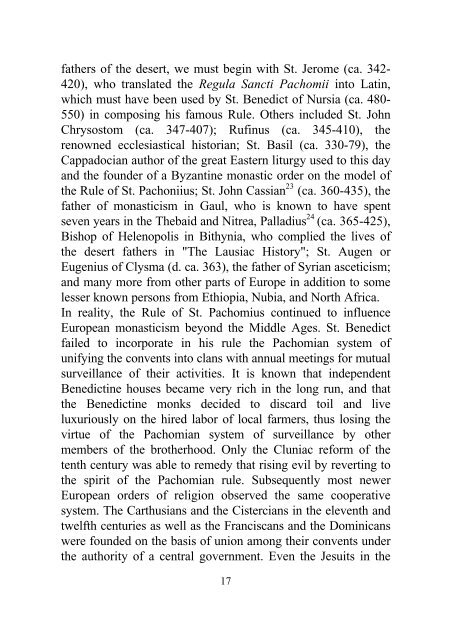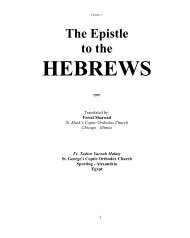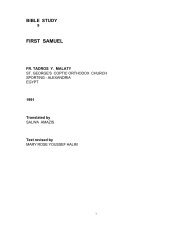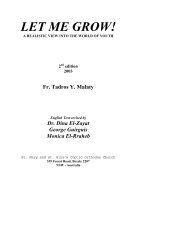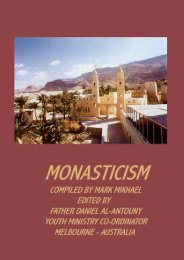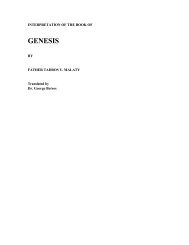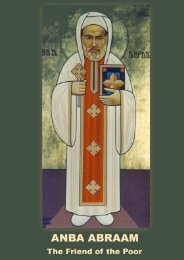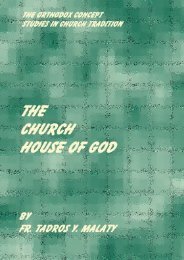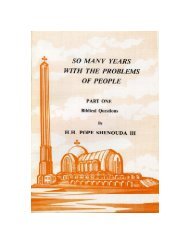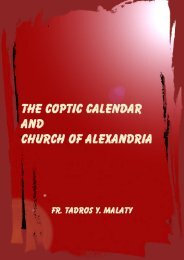the coptic contribution to christian civilisation - Fatherjacob.org
the coptic contribution to christian civilisation - Fatherjacob.org
the coptic contribution to christian civilisation - Fatherjacob.org
Create successful ePaper yourself
Turn your PDF publications into a flip-book with our unique Google optimized e-Paper software.
fa<strong>the</strong>rs of <strong>the</strong> desert, we must begin with St. Jerome (ca. 342-420), who translated <strong>the</strong> Regula Sancti Pachomii in<strong>to</strong> Latin,which must have been used by St. Benedict of Nursia (ca. 480-550) in composing his famous Rule. O<strong>the</strong>rs included St. JohnChrysos<strong>to</strong>m (ca. 347-407); Rufinus (ca. 345-410), <strong>the</strong>renowned ecclesiastical his<strong>to</strong>rian; St. Basil (ca. 330-79), <strong>the</strong>Cappadocian author of <strong>the</strong> great Eastern liturgy used <strong>to</strong> this dayand <strong>the</strong> founder of a Byzantine monastic order on <strong>the</strong> model of<strong>the</strong> Rule of St. Pachoniius; St. John Cassian 23 (ca. 360-435), <strong>the</strong>fa<strong>the</strong>r of monasticism in Gaul, who is known <strong>to</strong> have spentseven years in <strong>the</strong> Thebaid and Nitrea, Palladius 24 (ca. 365-425),Bishop of Helenopolis in Bithynia, who complied <strong>the</strong> lives of<strong>the</strong> desert fa<strong>the</strong>rs in "The Lausiac His<strong>to</strong>ry"; St. Augen orEugenius of Clysma (d. ca. 363), <strong>the</strong> fa<strong>the</strong>r of Syrian asceticism;and many more from o<strong>the</strong>r parts of Europe in addition <strong>to</strong> somelesser known persons from Ethiopia, Nubia, and North Africa.In reality, <strong>the</strong> Rule of St. Pachomius continued <strong>to</strong> influenceEuropean monasticism beyond <strong>the</strong> Middle Ages. St. Benedictfailed <strong>to</strong> incorporate in his rule <strong>the</strong> Pachomian system ofunifying <strong>the</strong> convents in<strong>to</strong> clans with annual meetings for mutualsurveillance of <strong>the</strong>ir activities. It is known that independentBenedictine houses became very rich in <strong>the</strong> long run, and that<strong>the</strong> Benedictine monks decided <strong>to</strong> discard <strong>to</strong>il and liveluxuriously on <strong>the</strong> hired labor of local farmers, thus losing <strong>the</strong>virtue of <strong>the</strong> Pachomian system of surveillance by o<strong>the</strong>rmembers of <strong>the</strong> bro<strong>the</strong>rhood. Only <strong>the</strong> Cluniac reform of <strong>the</strong>tenth century was able <strong>to</strong> remedy that rising evil by reverting <strong>to</strong><strong>the</strong> spirit of <strong>the</strong> Pachomian rule. Subsequently most newerEuropean orders of religion observed <strong>the</strong> same cooperativesystem. The Carthusians and <strong>the</strong> Cistercians in <strong>the</strong> eleventh andtwelfth centuries as well as <strong>the</strong> Franciscans and <strong>the</strong> Dominicanswere founded on <strong>the</strong> basis of union among <strong>the</strong>ir convents under<strong>the</strong> authority of a central government. Even <strong>the</strong> Jesuits in <strong>the</strong>17


